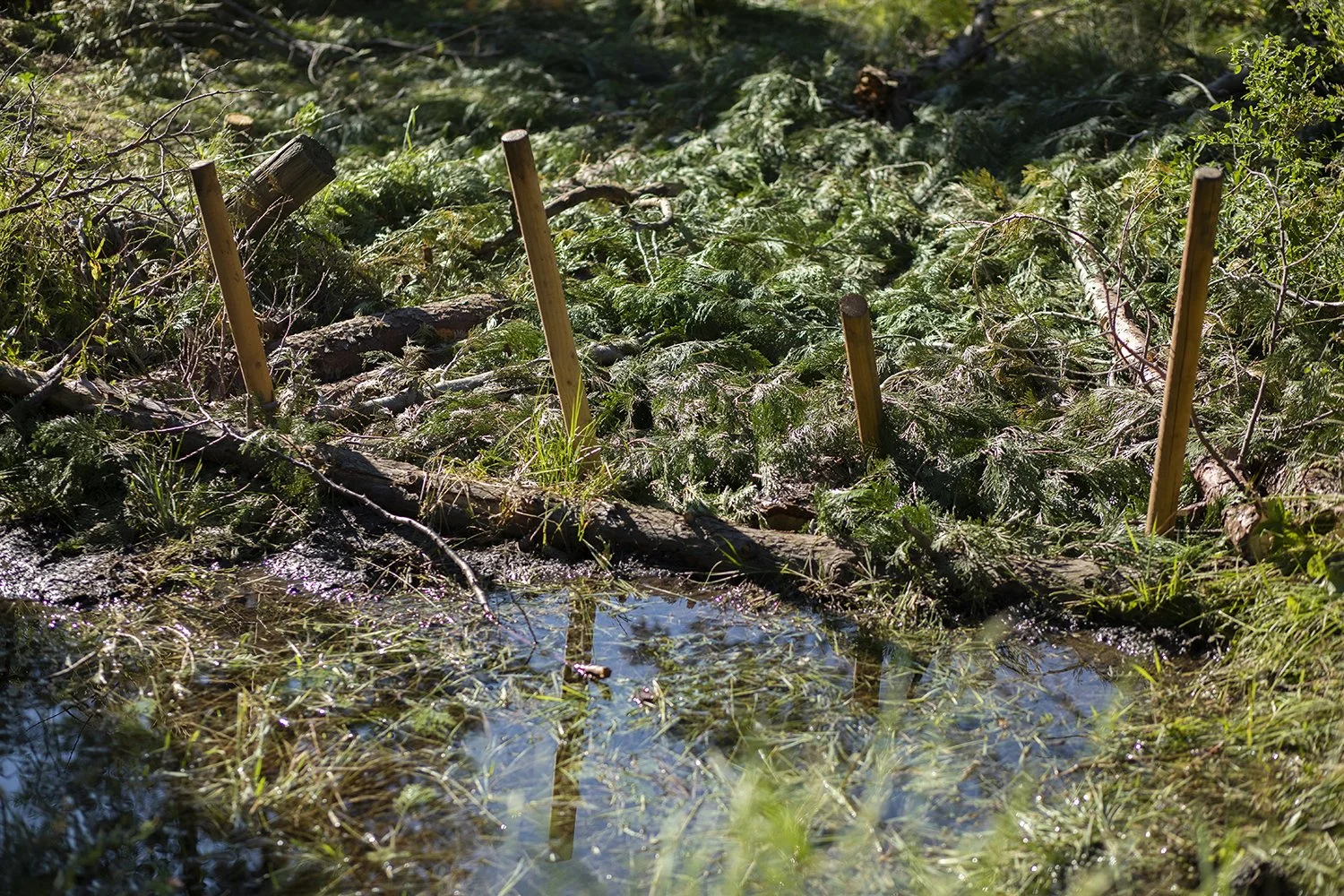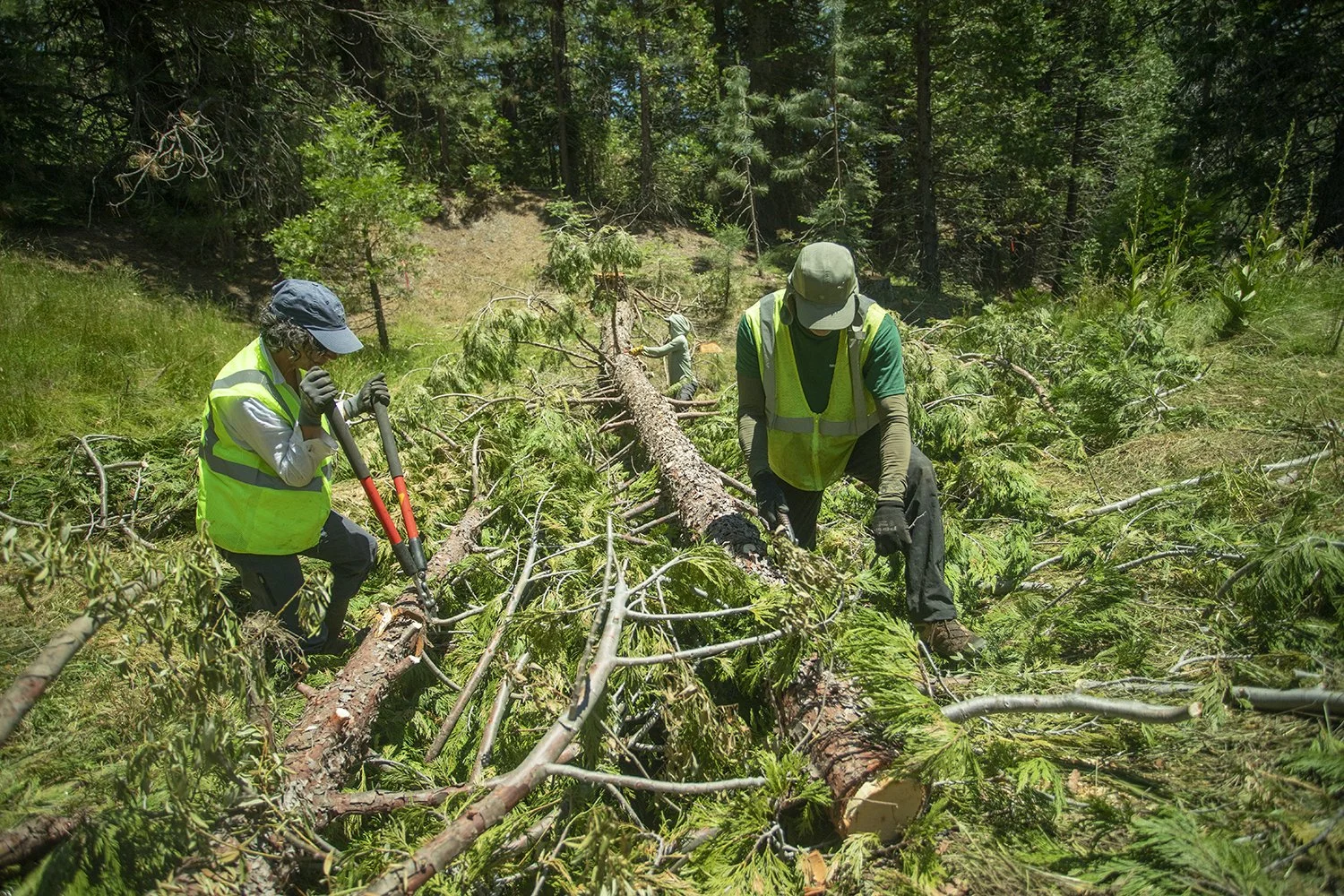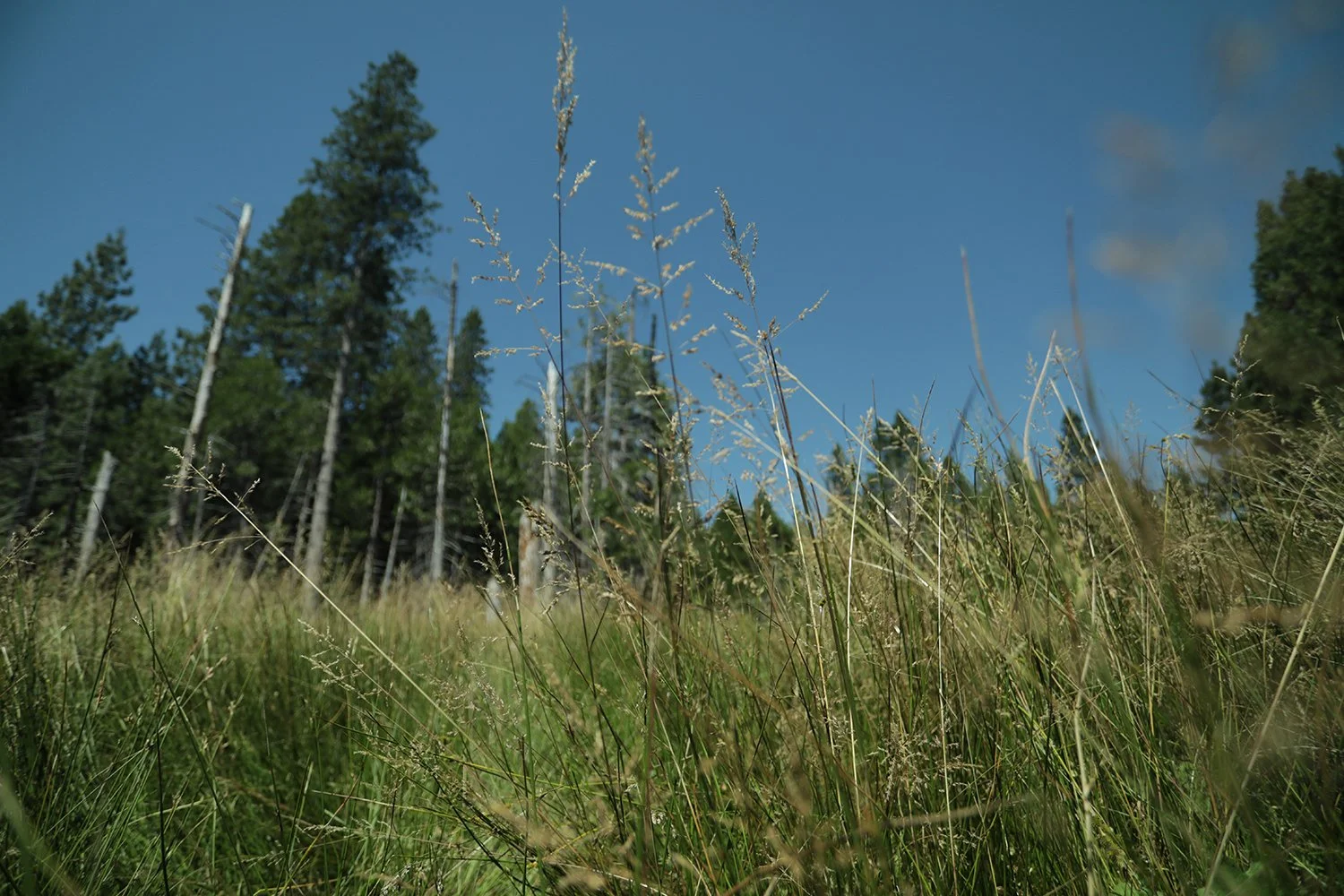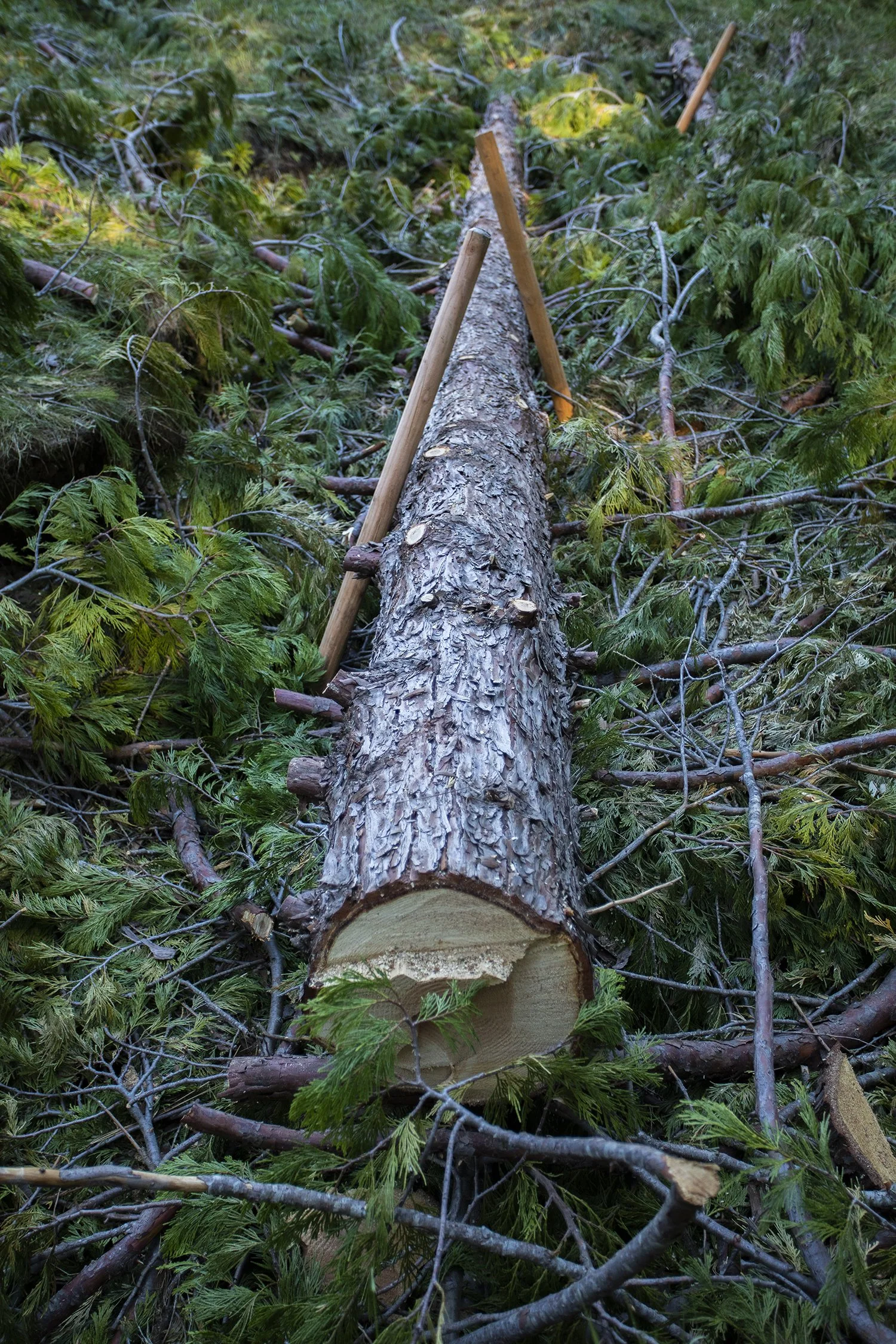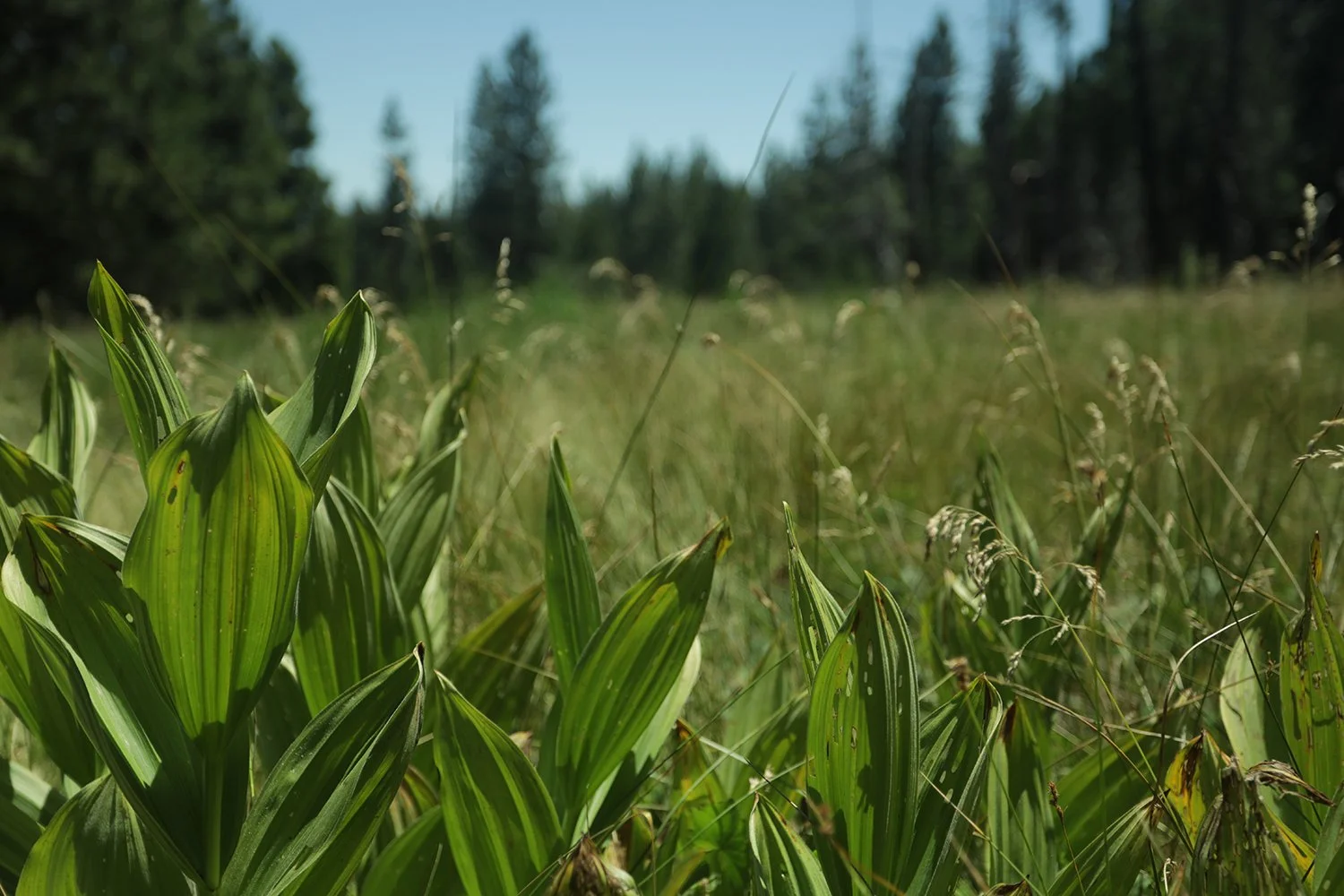Stream Work: People-Powered Restoration Returns Water to Boney Flat Meadow
Symbiotic Restoration crewmate works on an in-stream structure at Boney Flat Meadow
In early July, a plume of smoke rises tall, just a few hilly horizon lines beyond the bumpy Forest Service road that leads to Boney Flat Meadow. The Sheering Fire is 100-acres and burning through a small part of the dense and dry Stanislaus National Forest. It’s not a fire of great concern, but it looms as a reminder that fire is an everyday part of living in Western lands. By early July, Boney Flat Meadow is still green but heading towards its dried-out summer gold, dotted by native yarrow, remnant spring wildflowers, sedges and an expanse of grasses—some native, some not.
A lively soundscape emanates from the stream channel: pop music on portable speakers, the rip of chainsaws, the clink of shovels hitting dry ground. The stream is quick-moving, linear, and deeply incised into a small canyon about four feet below the meadow itself, completely disconnected from its natural floodplain.
“Falling!” shouts one of the sawyers on the crew, as a medium conifer breaks clean and pauses in slow-motion before gracefully crashing down to the meadow below—the sites and sounds of low-tech process-based restoration.
Nationally, a low-tech process-based restoration (PBR) culture shift is underway, powered by restorationists mimicking beaver in damaged local creeks, environmental agencies reconnecting floodplains on damaged public lands, and a rising public interest in low-tech, hand-done stream repair. At Boney Flat Meadow in the Sierra Nevada, Tuolumne River Trust is working with a coalition of crews including Symbiotic Restoration, National Civilian Community Corps, and Greater Valley Conservation Corps to use low-tech process-based restoration that will return water to this dry and damaged meadow in the Stanislaus National Forest.
Wetland meadows are thought to act as sponges, like firebreaks dotting fire-prone lands. Common sense adds up: you can’t burn a wet sponge and TRT is committed to restoring wet meadows in the Sierra Nevada to slow the spread of catastrophic megafires, protect a diverse and unique habitat, provide refuge for sensitive wildlife, and adapt to regional climate change projections.
Contemporary land use has left wet meadows in disrepair. At Boney Flat Meadow, surrounding roads and grazing cattle disconnected the meadow from its water in the first place, but low-tech process-based restoration returns water to these places and seeks responsive adaptation that meets the varied needs of cattle, human access, and the meadow ecosystem itself.
A road and culvert that run near the meadow have both exacerbated erosion; flexible meadow ecosystems don’t do well constrained by hard edges. Erosion around this historic culvert crossing has produced an eight to twelve foot deep stream channel that cuts its way downhill into the meadow. When the road’s solid edge meets back up with the stream at the bottom of the meadow it continues to deepen erosion in the stream bed.
Cattle, for their part, are allowed grazing rights in the National Forest through historic ranching permits. Holly Heath, a Restoration Coordinator with the Tuolumne River Trust shared that cow-like herbivores did not co-evolve with meadows in this region. “Buffalo didn't come to this side of the Sierra, we likely did not have elk. We have deer, but deer don't gather in numbers like cows do and don’t cause as much impact to a meadow; they are lighter, and naturally move around more because they are chased by predators like wolves or mountain lions,” Heath noted.
Cows tend to walk the path of least resistance often in or along creek channels where there’s water. By repeatedly walking in the same places, they erode the meadow and the stream bed: hooves leave deep pockmarks in the soil and the stream bank sloughs off, eroding as cattle seek access to water and green vegetation during the dry summer season. These extra impacts may seem small, but bit by bit, they drive floodplain disconnection over time.
Collaborative restoration offers new possibilities—timely and pressing opportunities in the face of a changing climate. Julia Stephens, Director of River and Meadow Restoration at Tuolumne River Trust, shared that, “the climate change models for the Sierra Nevada predict that over time more and more of our water will come from rain instead of snowpack. Snow can help store water longer into the summer season, making it more available for downstream ecosystems and for use throughout the year. Healthy meadow soils are something of a sponge and can also serve as a water storage method, helping to offset anticipated reduced snowpacks.”
Post-assisted log structure creates a pool in the stream at Boney Flat Meadow
This matters because California gets much of its fresh water from the Sierra Nevada, and historically its montane meadows acted as reservoirs that held and released melting snow water, steadily metering the flows throughout the entire year. Without functioning meadows, we’ll see a deluge of pre-melted rainwater during the wet seasons that runs itself right out of the system before the dry season even begins. This impacts water storage, the habitat function of meadows, as well as reduced fire resilience.
Expecting watersheds to function without well-connected floodplains is like expecting your own body to function without the systems that deliver water you drink to cells throughout your body. Through well-connected systems of porous intestines, networked bloodstreams, and permeable cell walls, we take a sip of water that hydrates our whole body. Now, imagine if these systems were disconnected from each other and the water you drank flowed efficiently through your body without hydrating you along the way.
Without water life collapses. Meadows exist to provide steady watershed hydration all year long. So, how do we let them do that?
Volunteers chop and prepare branches during a process-based restoration workday.
PALS Are Friends
By mid-morning at Boney Flat Meadow, an eager crew of volunteers begins to assemble. Garrett Costello, founder of Symbiotic Restoration and a contracted lead restorationist on this project, welcomes everyone and offers a brief introduction to the art of low-tech process-based restoration: “We make our structures really tight. So when you’re adding material we want it tight, low, locked, and wedged. We don’t want loose stuff that’s just gonna flow downstream or where water will flow under it. We want to create a series of little ponds. When we first got here, all the water was concentrated to this narrow slotted channel and now we have a series of ponds. The ponds are going to be good for amphibians and other wildlife, but they’re also going to allow sediment to slow down which will build soils back up in this channel and get it closer to the floodplain.”
On this workday the crew is making PALS or post-assisted log structures. Costello reminds the volunteers that they’ll add healthy chaos to the stream to slow down the water, build up the bottom of the stream bed, and create pockets of wetland habitat for sensitive species.
After Costello finishes his demonstration the volunteers get to it. A flurry of activity bursts forth based on his instruction: digging up clumps of sod from the stream bank to place in the stream bed, chopping branches on felled cedar trees, strategically stuffing these branches in between vertical posts that cross the stream bed like a flexible wall.
The team develops large “aprons” made of fresh cedar branches on the back edge of the structures. Aprons are springy mats horizontally covering sections of the stream where head cuts have emerged.
In small streams like these, head cuts are small waterfalls and places where an often unnatural source of degradation has caused the stream to pick up too much speed and force; their presence signals active erosion in process. Costello describes it like a zipper, “the erosive force of that water will keep cutting the stream bed backwards upstream, cutting the stream bed into itself deeper and deeper, farther away from the meadow.” Post-assisted log structures are built downstream of head cuts. The structures cause water to back up, eliminating the waterfall and preventing continued erosion.
Low-tech process-based restoration like this is a suite of practices enacted by humans who mimic their nature-based counterparts. Whether through mimicking beaver or the useful chaos of storms, the idea is that these natural systems will only restore if complexity is returned, by hand or by beaver.
For this project Tuolumne River Trust has received the proper government permits to mimic log jams and not beaver dams. Post-assisted log structures (PALS) vary slightly from another popular process-based restoration technique called beaver dam analogues.
TRT Restoration Specialist, Margaret Thompson, adds cedar branches to the apron of a post-assisted log structure
“From our current understanding, beavers are not known to be native to this area of the Sierra Nevada; we are cautious not to introduce a species to a habitat unless we are confident that species is, or has historically been, a part of that habitat," Heath shared.
Post-assisted log structures operate similarly to beaver dams and their analogues, but more closely emulate seasonal storm-driven log jams, jumbles of woody debris, and sediment accumulation. In a meadow with such a degraded stream channel, natural tree fall is not enough—an accelerated pace helps.
And even after a short while, the work of the volunteers at Boney Flat has a visible effect. After just a few hours of stuffing branches and logs around the post structures, water pools up around the PALS. Once the water pools, it begins to seek more places to slow, settle, and sink into the ground. Downstream, slow gentle pools begin to flood up against the structures and a thin layer of water spreads out laterally, trickling between bunches of clover and grass.
Conifer trees surround the meadow; as the meadow dries, more conifer trees will take root here.
Of Fire and Transformation
“Meadows can serve as a fuel break when fire moves through the forest; the wetter soils allow plants within the meadow to recover more quickly, protecting roots and soil health,” shared Stephens.
She goes on to share that during restoration the team cuts small trees in the surrounding forest and meadow, utilizing them for in-stream restoration structures. Thoughtfully cutting down select trees helps in many ways. This creates clear paths outside of the meadow for cows to walk on, while also reducing conifers that move into the meadow and dry it out further with their own needs for water.
Not all land in this section of the Sierra Nevada was meant to be forest. When a meadow begins to dry out, trees that can’t otherwise grow in wet conditions begin to thrive.
This jumble of woody debris mimics storm-driven log jams and adds healthy complexity to streams.
“Often meadows are surrounded by fire-suppressed forest with a dense understory of small trees. Reducing fuels in and around the meadow allows it to stay wetter and serve better as a fuel break, while at the same time making that water more available for perennial plants, sedges, willows, and other meadow-dependent species,” Stephens shares about the connection between wet meadows and fire resilience in the Sierra Nevada.
When the larger montane ecosystem is no longer dotted with spongy wet meadows dense forest is everywhere, which contributes additional imbalance to already fire prone Western lands.
Emily Fairfax, ecohydrologist, beaver researcher, and professor at the University of Minnesota, wrote in a recent paper that six other independent scientists have each independently proven that “increasing air temperatures, drier riparian conditions, and disconnection of vegetation from floodplains drives the wildfires of yesterday into the megafires of today.”
In many of her studies and papers Fairfax often refers to well-connected floodplains as speed bumps and networked firebreaks that slow down catastrophic fires. The slow pooling of water in wet meadows supports human communities and towns while also providing habitat and refuge for small animals and amphibians, both those that are officially endangered in the Sierra due to wet meadow habitat loss, such as the little willow flycatcher and Sierra Nevada yellow-legged frog, as well as larger animals seeking refuge during an active fire.
Fens and Futures
Cailey Baker, a TRT Restoration Project Manager at Boney Flat, shares the restoration goals at Boney Flat set out to maintain and enhance water quality and riparian habitat alongside creating more connectivity between the meadow, the stream, and the sensitive fen at Boney Flat.
Looking toward the fen at Boney Flat Meadow in the Stanislaus National Forest
Fens are peat-rich wetlands that rely on groundwater to develop. They are unique habitats for many rare species. “Fens take thousands of years to form, so we take protecting them from drying out very seriously,” Baker noted. The fen at Boney Flat Meadow is full of springy carbon-sinking peat that is drying out over many years of degradation. Baker went on to share, “as the peat in the fen dries out, oxygen enters the soil and increases decomposition rates. As a result, the peat breaks down, the plant community changes, and the fen can be destroyed over time.”
Once the in-stream structures are built there will be plenty of need to monitor their effect. “After the project is fully implemented, TRT staff will return to plots established before restoration in order to study changes in vegetation. We are particularly interested in seeing if restoration actions cause a shift in the dominant plant community from more upland plant species to more wetland species. This trend would indicate a wetter meadow overall, which means our restoration actions have moved us closer to our goals,” said Baker.
Alongside the fens, streams, frogs, and fire resilient lands there are also human characters in this story. “For me, this work signals a culture shift too, one we greatly need,” shared Costello. That culture shift is embodied at Boney Flat Meadow by the people doing this care work, slowly at a non-mechanized pace, in community, and in relationship to the land itself, while making an economic living in return.
Forest service scientists and TRT teammates walk through the fen at Boney Flat
This too, tracks with many climate resilience models that consider the ecological environment alongside the social and economic needs of human communities. At Boney Flat Meadow, a web of community-powered climate resilience is woven by this work: federal agencies partner with TRT who hires a small restoration business and inspires a coalition of volunteers, college students, AmeriCorps members, and restorationists from Tuolumne County, all bonding together in their shared care for a meadow, its sensitive species, the fire resilience of their towns, and the water that sustains life across the watershed.
Over the next years, TRT will work on several other meadow restoration projects: Cottonwood Meadow a large 74-acre meadow in the Stanislaus National Forest and a 27-acre meadow at Murphy Ranch—lands owned by the Tuolumne Band of Me-Wuk Indians, who TRT is supporting with planning, designing, fencing, and permitting for process-based restoration work.
At Boney Flat Meadow, after a summer of work, positive shifts are already emerging. “Crews see the creek holding and releasing water more slowly, and the meadow areas connected to the creek are staying green longer,” noted Stephens. In the future, TRT hopes to continue seeing decreased erosion and increased water in the meadow.
The art of process-based restoration builds on itself from year to year. Protecting these sensitive wetland habitats is a slow and steady collaboration that addresses the impacts of climate change for and with the people, animals, and river-based ecosystems of the Greater Yosemite Region.
Thank you to California Department of Fish and Wildlife Nature Based Solution: Wetlands and Mountain Meadows program for supporting this phase of work at Boney Flat Meadow.
Our work is supported and bolstered by our generous community of donors. If you have a heart for salmon, connected rivers, and healthy ecosystems throughout the Tuolumne Watershed and the Greater Yosemite Region, become a member today!


